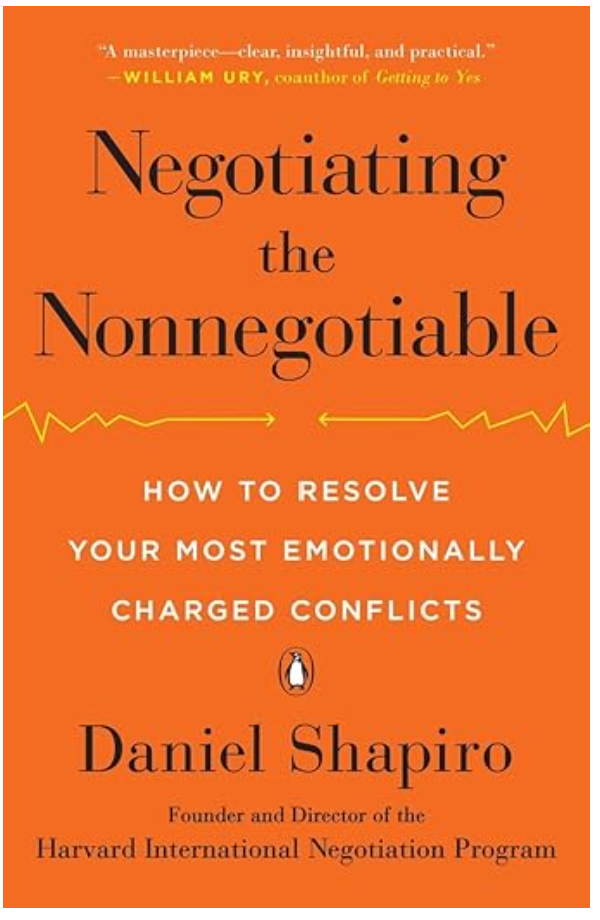Negotiating the Nonnegotiable – Defusing High-Emotion Workplace Conflicts
The Workplace Problem: How Can Professionals Resolve Deep-Rooted, Emotionally Charged Conflicts?
In professional settings, conflicts often arise that are deeply intertwined with personal identities and emotions. These disputes can escalate, leading to strained relationships, decreased productivity, and a toxic work environment.
So, how can professionals navigate and resolve conflicts that seem nonnegotiable due to their emotional intensity?
What This Book is About
Negotiating the Nonnegotiable by Daniel Shapiro, founder and director of the Harvard International Negotiation Program, delves into the psychological underpinnings of conflicts that appear insurmountable. Shapiro introduces the concept of the "tribal mind," explaining how our deep-seated identities and emotional triggers can entrench us in disputes. The book offers a framework to recognize and address these emotional forces, providing strategies to transform adversarial interactions into collaborative problem-solving.
Key Takeaways for HR and Workplace Leaders
Understanding the "Tribal Mind": Recognize how personal and group identities influence conflicts, leading to entrenched positions.
Identifying Emotional Forces: Be aware of five emotional dynamics that can escalate conflicts:
Vertigo: Becoming consumed by the conflict.
Repetition Compulsion: Repeating the same arguments without resolution.
Taboos: Avoiding sensitive topics that need addressing.
Assault on the Sacred: Perceiving core values as being attacked.
Identity Politics: Us versus them mentality.
Strategies for Resolution:
Address Emotional Pain: Acknowledge and work through emotions to prevent them from hijacking the resolution process.
Build Relational Identity: Focus on shared goals and values to bridge divides.
Discuss the Undiscussables: Create a safe space to talk about taboo subjects that fuel underlying tensions.
Workplace Tools and Models from the Book
The "Relational Identity Theory" Framework: A model to understand how relationships and identities intersect in conflicts.
Emotional Temperature Gauge: A tool to assess and manage the emotional intensity of a conflict situation.
Taboo Discussion Protocol: Guidelines for safely bringing up and addressing topics typically avoided in workplace discussions.
Why This Matters for HR and Workplace Leaders
HR professionals and leaders are often called upon to mediate disputes that are not just about policy or procedure but are deeply personal and emotional. Negotiating the Nonnegotiable provides insights to:
✔ Enhance Conflict Resolution Skills: Equip leaders with tools to navigate emotionally charged disputes effectively.
✔ Foster a Collaborative Culture: Encourage open discussions about identity and values, leading to a more inclusive workplace.
✔ Prevent Escalation of Disputes: By recognizing and addressing the emotional roots of conflicts early, prevent them from becoming unmanageable.
How This Connects to Workplace Assessments and Restorations
Workplace assessments often reveal underlying tensions related to identity, values, and unspoken taboos. By applying Shapiro's principles, HR leaders can:
Uncover Hidden Sources of Conflict: Identify and address the emotional and identity-based roots of workplace disputes.
Develop Training Programs: Implement workshops that teach employees how to manage their "tribal mind" and engage in constructive conflict resolution.
Enhance Team Cohesion: Build a culture where diverse identities are acknowledged and respected, reducing the likelihood of identity-based conflicts.
How Can You Apply This?
➡️ Are there recurring conflicts in your workplace that seem resistant to traditional resolution methods?
➡️ Do disputes often feel personal, with parties feeling their core values or identities are under attack?
Applying the strategies from Negotiating the Nonnegotiable can help transform these deeply rooted conflicts into opportunities for understanding and collaboration.
Where to Buy
Interested in reading Negotiating the Nonnegotiable: How to Resolve Your Most Emotionally Charged Conflicts? You can purchase it here:
📚 Amazon
📚 Penguin Random House

